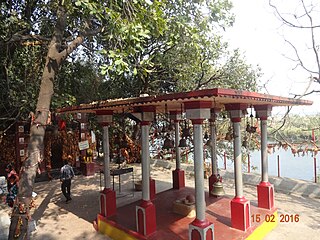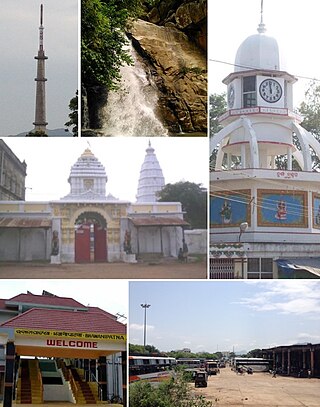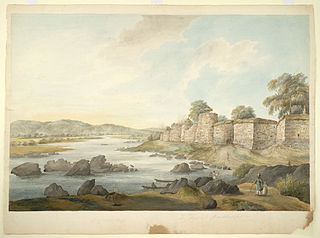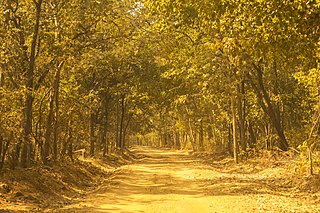
Odisha, formerly Orissa, is an Indian state located in Eastern India. It is the eighth-largest state by area, and the eleventh-largest by population, with over 41 million inhabitants. The state also has the third-largest population of Scheduled Tribes in India. It neighbours the states of Jharkhand and West Bengal to the north, Chhattisgarh to the west, and Andhra Pradesh to the south. Odisha has a coastline of 485 kilometres (301 mi) along the Bay of Bengal in Indian Ocean. The region is also known as Utkala and is mentioned by this name in India's national anthem, "Jana Gana Mana". The language of Odisha is Odia, which is one of the Classical Languages of India.

Baripada is a city and a municipality in Mayurbhanj district in the state of Odisha, India. Located along the east bank of the Budhabalanga river, Baripada is the cultural centre of north Odisha. In recent years, it has emerged as an educational hub with the opening of numerous professional colleges.
Bargarh is an emerging city and municipality in Bargarh district in the state of odisha in India. It is the administrative headquarters of Bargarh District. Bargarh is popularly known for intensive cultivation of 'paddy', therefore called "Bhata Handi" of Odisha.

Sambalpur District is a district in the western part of state of Odisha, India. The historic city of Sambalpur is the district headquarters.

Burla is a locality in Sambalpur city in the state of Odisha, India. It earlier had a Notified Area Council (NAC) until 2014 after which it was included in Sambalpur city under Sambalpur Municipal Corporation (SMC). It was earlier a small town on the banks of Mahanadi. One can reach this place by road with National Highway 6 which is one of the busiest trunk routes in India as it connects Hazira to Kolkata. Hirakud Railway Station is at one end of the town and a walking distance from the Mahanadi Coal Limited (MCL).

Bhawanipatna is a city and the headquarter of Kalahandi district in the state of Odisha, India. Bhawanipatna has numerous temples dedicated to different deities of the Hindu pantheon. It is named after the presiding deity, Bhawani-Shankar, and Patna, which means "place" in Odia.
Sambalpur is the fifth largest city in the Indian State of Odisha. It is located on the banks of river Mahanadi, with a population of 335,761. Prehistoric settlements have been recorded there. It is the home of the Sambalpuri sari.

Hirakud Dam is built across the Mahanadi River, about 15 kilometres (9 mi) from Sambalpur in the state of Odisha in India. It is the longest earthen dam in the world. Behind the dam extends a lake, Hirakud Reservoir, 55 km (34 mi) long. It is one of the first major multipurpose river valley projects started after India's independence. Hirakud Reservoir was declared a Ramsar site on 12 October 2021.

Hirakud is a small township located in Sambalpur in Odisha. It was a Notified Area Council (NAC) which was later included along with Burla in Sambalpur city to become a Municipal Corporation. This city is a hub of HINDALCO, an Indian aluminium and copper manufacturing company. Hirakud Dam, is one of the most visited tourist spot. It is one of the longest and largest dams in the world. It is constructed across the Mahanadi river between the Gandhi Minar in North and the Nehru Minar in the South, which connects these two hills. The shoreline spans around 640 km. This dam had a generating capacity of 290MW.

Khariar is a city and a Notified Area Council in Nuapada District of the Indian state of Odisha.

Samaleswari Temple is a Hindu temple in Sambalpur, Odisha, India, dedicated to the goddess known as 'Samaleswari', also known among the natives as samalei maa, meaning Mother Samaleswari. Shree Shree Samaleswari, the presiding deity of Sambalpur, is a strong religious force in western part of Odisha and Chhattisgarh state of India. On the bank of the river Mahanadi, the mother goddess Samaleswari is worshipped from ancient times as Jagatjanani, Adishakti, Mahalaxmi and Mahasaraswati, and is the mother of the universe. After Lord Jagannath, she is the only Goddess in Odisha who is the presiding deity of such a large region including the complete Western Odisha, parts of Jharkhand and Chhattisgarh. The region in which the temple is situated has a rich cultural heritage. Sambalpur region is popularly known as Hirakhanda from ancient times. Ptolemy has described the place as Sambalaka, according to Tavernir, the French explorer, and Edward Gibbon, the English historian, diamonds were exported to Rome from Sambalpur.

Samaleswari is the tutelary goddess of Sambalpur.
Western Odisha is the western part of the state of Odisha in India, extending from the Kalahandi district in the south to the Sundargarh district in the north.
Tourism in Odisha is one of the main contributors to the economy of Odisha, India, with a 500 km (310 mi) long coastline, mountains, lakes, natural biodiversity and rivers. Odisha is a major tourist destination in India, with various tourist attractions, including wildlife reserves, beaches, temples, monuments, the arts and festivals. Other than wildlife reserves, beaches, temples, monuments, the arts and festivals, the Odisha Tourism Development Corporation, a public sector undertaking of the Government of Odisha, is also developing the tourism sector of Odisha and India.

Sambalpur is a district of Odisha. Sambalpur city is the headquarter of Sambalpur district. Sambalpur is the cultural capital of Western Odisha.
Established in 1962 over a forest area of about 304.03 square kilometres, the Ushakothi Wildlife Sanctuary is situated at a distance of about 22 kilometres from Sambalpur. To the west of the Sanctuary lies Hirakud Dam. Principally dry deciduous forest type, floral species like sal, sandalwood, arjun, neem, acacia, casuarinas are of frequent occurrence. The fauna includes, amongst others, tigers, elephants, sambar leopards and bison. Presently there are about 15 tigers and 35 elephants in the sanctuary. It is rich in avifaunal wealth and the main attraction of this sanctuary are racket tail drangos and flying squirrel. For night halts there is one two roomed forest rest house inside the sanctuary. The reservations can be done through the Divisional Forest Officer of the same sanctuary, Sambalpur.

Sambalpur is a city in Sambalpur district in the Indian state of Odisha. It lies at a distance of 321 km from the state capital Bhubaneswar. In the year 1876, Sambalpur was established as a municipality. It is currently the headquarters and the largest city of Sambalpur district. It is also the commercial capital of Western Odisha. Sambalpur is famous for Hirakud Dam, Sambalpuri Saree, Sambalpuri songs, Sambalpuri dance, the Sitalsasthi Carnival, The Leaning Temple of Huma and Gandhi temple.

Prem Ram Dubey was an Indian lawyer and politician. He was the founding father of the Kosal State Movement, which campaigns for statehood for Western Odisha.

The Debrigarh wildlife sanctuary is located in the Bargarh district in the Indian state of Odisha, covering a total area of 346.91 km2. It is situated near the city of Sambalpur's Hirakud Dam. The Debrigarh Wildlife Sanctuary is an important location for the conservation of various local wildlife and their habitat. It is home to a wide variety of flora and fauna. Over 40 species of mammals, 200 species of birds, 40 species of reptiles, 12 species of amphibians, 42 species of fishes, 39 species of odonates, 85 species of butterflies and 38 species of spiders have been found living in the sanctuary.
Bhikampali is a medium-sized village in the Jharsuguda district of Odisha, India. It is situated on the banks of Badkelo River in the foothill of Chhelia Pahad. The village is located at a distance of 60 km from the district headquarter of Jharsuguda. It is within the Brajarajnagar assembly constituency, and the Bargarh Parliament constituency. As of 2011 census, its population is 920.
















